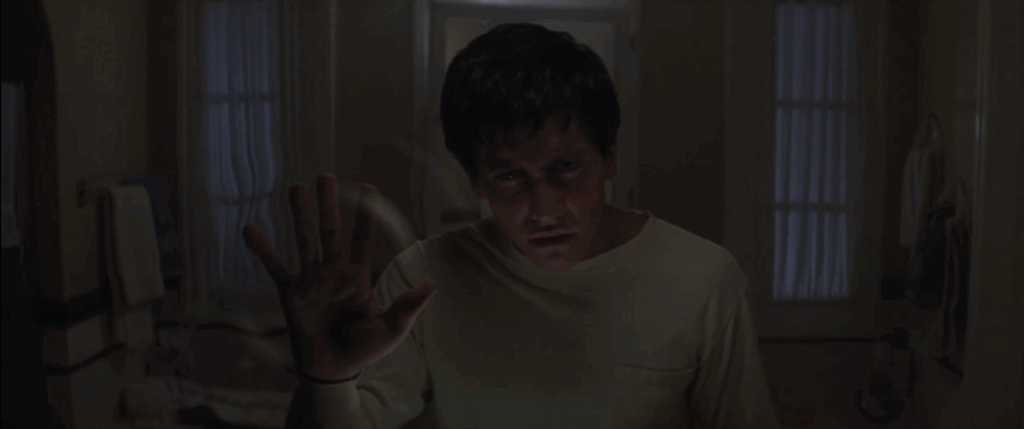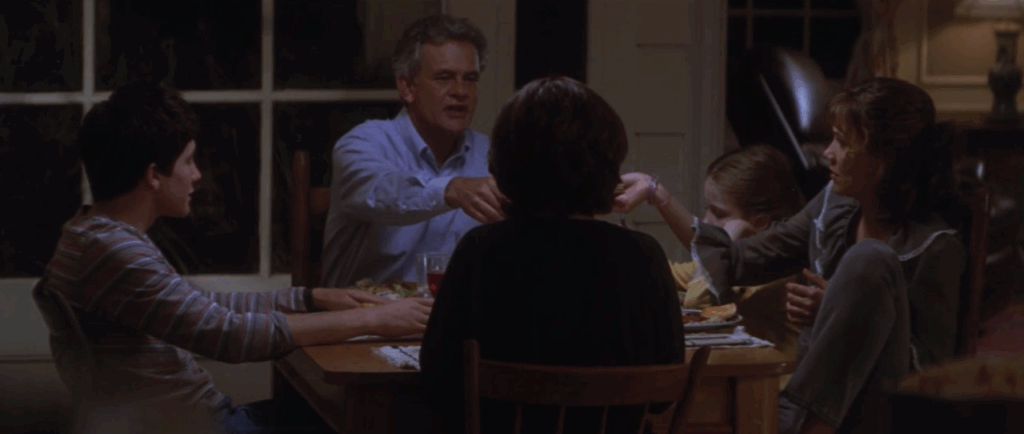| Ryan Sanderson |

Donnie Darko plays on glorious 35 mm at the Trylon Cinema from Friday, July 18th, through Sunday, July 20th. For tickets, showtimes, and other series information, visit trylon.org.
When I began this process, I did not know how personal writing about Donnie Darko would feel. It was never one of my favorite films. I was introduced to the film by my freshman roommates alongside a rolling festival of late 90s/early aughts male angst classics like Fight Club and Clerks. I wasn’t ready at nineteen to internalize the film completely, but I couldn’t reject it either, so I found a place to compartmentalize everything the film had to say about mental health, social regression, the challenges and opportunities of both being a teenager and being one of the people in a teenager’s life.
These are fraught subjects, probably everywhere, but especially in the United States. In the decades since Donnie Darko, we’ve seen the appalling cynicism with which our politicians treat youth safety and adolescent mental health. The film was released in 2001 and set in 1988, both eras of conservative resurgence in America—many of the politicians most guilty of using “protecting children” as an excuse to pass bills which harm them, who refuse to address the real issues that make them unsafe, are the direct descendants of the figures on the Darko television. Donnie Darko is a paranoid gothic fairy tale for teenagers, but it’s also more directly instructive for the Karen Pomeroys (Drew Barrymore) and Rose Darkos (Mary McDonnell) in the audience. Note how the ominous score builds when Rose talks to Kitty Farmer (Beth Grant). When I was younger, I thought Kitty was solely a comic figure, someone meant to show you exactly how not to work with teenagers, played for scorn and pity. Only now do I recognize that the film is inviting the audience to ask that very question—is she only silly? Might she be dangerous?
This is at least part of the point of Donnie Darko (and, say, Romeo and Juliet): teenagers are inevitable. Hormones, underdeveloped frontal lobes, a capacity to learn and adapt that borders on a superpower. The only true way to keep them safe is to build a world that makes room for them to figure shit out. It’s not that they’re wholly not responsible for their actions, but people around the world recognize that teenagers present a unique case. The Declaration of the Rights of Children, which lays out special cases for dealing legally with humans under 18, has been ratified by every country in the world with a single exception. Somalia ratified it in 2015, making the United States the only holdout.

I don’t know many families like the Darkos, people who vote Republican but let their children swear at the dinner table. I’m sure they exist. I also don’t mean to reduce one of the most enigmatic films of the early 2000s (certainly the most enigmatic being offered to me and my teenage peers at the time) to a single line from Lady Bird. Donnie Darko has so much on its mind that I’m not sure it’s advisable to try to touch on all of it in a single short essay. At the same time, it’s also intimately focused on the interconnectedness of things. Kitty is a one-dimensional person easily swayed by a charlatan and monster like Jim Cunningham (Patrick Swayze). She convinces Rose to leave Donnie in a vulnerable moment. We all laugh at the Sparkle Motion line, but again, I think the comedy here is hiding the true danger of her request. Because Rose leaves, Donnie is unsupervised to go through with his plan. If you view the ending as a metaphor for teenage suicide—which I certainly feel is on the table after watching four times this last month—then her failing to be around for her son because of Kitty’s false crisis is one of the most tragic choices in the film. Rose even realizes this, weighing her options before succumbing to social pressure.
Historically speaking, teenagers have a reputation for overreacting. That’s the common wisdom, and I can speak from personal experience that it was occasionally true. However, that doesn’t mean their point of view is invalid. And it doesn’t mean that they’re wrong, either. When Donnie tells Jim Cunningham he’s “the fucking antichrist,” he’s right. Men like Jim Cunningham were positioned/are positioned all through the social movement which Donnie Darko depicts, using their privileged position to exploit vulnerable people. When Donnie tells off Kitty in front of her chalkboard, he’s also right. Her “love/fear” belief system is sort of a euphemistic parallel to the Christianized socialization methods pushed through conservative communities in the eighties. I suspect Kitty has a few James Dobson books at home. We’re living the consequences of those programs today.

Of course Donnie’s not just about politics, although I think it questions the validity of anything being just about politics, frequently juxtaposing political subjects like the Dukakis vs. Bush debate with real-world parallels, like the Darko family’s liberal relationship to their children’s autonomy. It uses fantasy and all the background lore I would have found much more interesting twenty years ago to draw shapes around the forces moving through our world. Throughout the film Donnie does every dangerous and wrong thing a kid could do. The film’s first image is him sleeping in the middle of the road. He defaces the school, burns a house down, kills someone, and dies on purpose, all wholly justified by the story inside his head. In his immediate orbit teenagers drink and do drugs and shout racist insults at shy, gentle Cherita Chen (Jolene Purdy). Donny cosigns much of this behavior. We see—I wish a little more sharply—through Cherita’s eyes how that unsparing teenage certainty can lead to cruelty as often as insight.
When I knew I would be writing about Donnie Darko, the first thing I did was go for a walk listening to Gary Jules’s cover of Tears for Fears’ “Mad World.” It wasn’t the first time I’d done this, but it had been many, many years. In the period between when Donnie Darko was released and when I first saw it, I regularly made mix CDs of the saddest music I could find. It included most of the bands you’re probably thinking about right now, as well as their Christian alternatives, and “Mad World,” which I thought was just about the saddest song I’d ever heard. It wasn’t just the lyrics. The Tears for Fears version uses those same lyrics much differently. When Curt Smith sings, “I find it kind of funny, I find it kind of sad,” you suspect that the funny might take precedence. There’s a deranged glee to it. Whereas Jules’s delivery is so defeated, as though he’s fully resigned himself to this world of “worn-out faces” and “children waiting for the day they feel good.” I choreographed melodramatic images to that music, imagined dying, imagined suffering.

I wouldn’t necessarily rebuild the world around any of the individual thoughts I had listening to that music, but still I think its overall impact was healthy. Or at least healthier than the other available alternatives. It told me to treat my feelings and observations like they mattered in a world where that message was often either missing or dangerously amended. Is it inarguably safe to encourage or normalize everything that happens in this film? Probably not. I think our cultural conversation on that subject is in a different place than it was twenty-four years ago. But as Donnie Darko shows (alongside frequent current events), it’s far, far more dangerous to leave teenagers without emotional outlets, or to try to restrict what they’re allowed to know and understand. Frankly, I don’t think there is a 100% safe option, and the desire to find one almost certainly means less safety overall.
Likewise, there’s nothing safe or certain about Donnie Darko. Moments in the film feel difficult at best, borderline irresponsible at worst. That’s too big a subject for a 1500-word blog post. But while I can no longer fully summon the violent, overwhelming emotions I felt listening to Anberlin and Yellowcard and The Killers and “Mad World” on a walkman biking through my neighborhood almost twenty years ago, I still feel overwhelmed and tremendously moved by Donnie Darko. I’m moved by its honesty, by its love for its subjects and its target audience, by its audacity and scale. I’m moved by its urgency, an urgency I still think is well-placed. When I saw the film at nineteen, I thought it was a perfect, almost overly simple depiction of so many forces and situations I took for granted in adolescence. I thought I understood the film better than I do now. Maybe I did.
Edited by Olga Tchepikova-Treon
